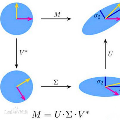The estimation of the treatment effect is often biased in the presence of unobserved confounding variables which are commonly referred to as hidden variables. Although a few methods have been recently proposed to handle the effect of hidden variables, these methods often overlook the possibility of any interaction between the observed treatment variable and the unobserved covariates. In this work, we address this shortcoming by studying a multivariate response regression problem with both unobserved and heterogeneous confounding variables of the form $Y=A^T X+ B^T Z+ \sum_{j=1}^{p} C^T_j X_j Z + E$, where $Y \in \mathbb{R}^m$ are $m$-dimensional response variables, $X \in \mathbb{R}^p$ are observed covariates (including the treatment variable), $Z \in \mathbb{R}^K$ are $K$-dimensional unobserved confounders, and $E \in \mathbb{R}^m$ is the random noise. Allowing for the interaction between $X_j$ and $Z$ induces the heterogeneous confounding effect. Our goal is to estimate the unknown matrix $A$, the direct effect of the observed covariates or the treatment on the responses. To this end, we propose a new debiased estimation approach via SVD to remove the effect of unobserved confounding variables. The rate of convergence of the estimator is established under both the homoscedastic and heteroscedastic noises. We also present several simulation experiments and a real-world data application to substantiate our findings.
翻译:处理效果的估算往往有偏差,因为存在未观测到的、通常称为隐藏变量的折折变变量。虽然最近提议了一些方法来处理隐藏变量的影响,但这种方法往往忽略观测到的处理变量和未观测的共差体之间任何互动的可能性。在这项工作中,我们通过研究多变反应回归问题来解决这一缺陷,研究多变反应回归问题,研究多变反应回归问题的方法是:以未观测和混观测两种不同的调解变量(以Y=A=AQT X+B+BQT =====Sx+BQQQT===1 ⁇ CT_jX_jZ+E$,最近提出了一些方法处理隐藏变量(以美元计算,而以美元表示的正正正正正值的正值的快解解解(包括治疗变量), 以千变回回回回的 以Z 美元=美元, 以美元 以美元 以 立 立 立 立 法 立 法 和 立 立 立 法 法 法 。 以 立 立 立 立 立 立 立 立 法 立 立 立 立 立 立 法 立 立 立 法 立 立 立 以 立 立 以 立 立 立 立 立 立 立 以 立 立 立 立 立 立 立 立 立 、 立 立 法 、 立 立 立 法 立 、 法 立 立 立 法 法 至 立 至 立 立 立 立 立 法 法 立 立 至 立 立 立 至 立 立 法 立 法 、 、 至 至 立 立 法 至 立 至 立 立 立 立 立 立 立 立 立 、 至 至 直 立 立 立 立 立 、 立 、 法 立 立 立 立 立 法 法 立 立 立 立 立 法 、 立 直 法 直



